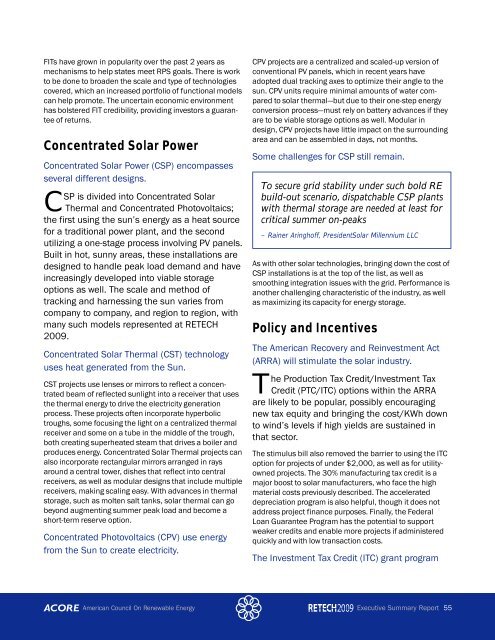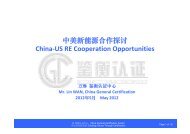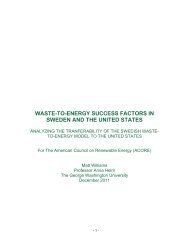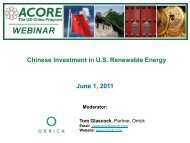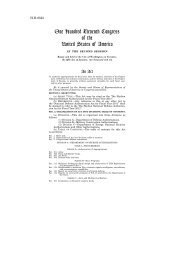of Dow Corning Solar Solutions. The current economicconditions have slowed the pre-recession solar boom’sdemand glut into an inventory surplus, but as the ARRAstimulus programs kick in, finding solutions to materialcosts and availability will again be a key challenge forsolar energy to overcome.There are several solar power-generationownership models.There are four major solar ownership models, says SteveChadima, Chairman of the Solar Alliance. In some cases, acustomer or third-party owned distributed generation canoffset load, in other cases, customers buy “shares” inutility-owned projects. Additionally, some third-partysystem owners sell wholesale electricity to the utility undera Power Purchasing Agreement (PPA). The last ownershipmodel is utility-owned generation, where the sale of solarenergy works much in the same way as through traditionalpower plants.Getting down to business: Solar incentives indetailSolar has been incentivized in different ways, falling underthe following general headings: tax incentives, directincentives, REC incentives, feed-in tariffs, and standardoffercontracts.•With tax incentives, a fixed percentage of system costis subtracted from taxes owed, reducing the cost ofimplementation, not impacting electricity prices, andproviding easy implementation. Tax incentives do not,however, have a built-in mechanism to maximize solarimplementation or to drive prices lower. They may strain astate budget if many projects are implemented in a shortamount of time. And as seen during the current recession,a simple reduction in taxes often leaves behind still-highcosts that are difficult to account for in a tight creditmarket.•Direct incentives come up-front, usually for smallersystems, rewarding performance at a decreasing rate overtime. While reducing costs for smaller users, directincentives can also help ease energy prices by encouragingperformance. Direct incentives are an appealingchoice as they drive down prices and maximize production,but there is speculation about how scaleable directincentives may be without significant impact to energyprices, and whether incentives fall in line with a sustainedrate of growth in the solar sector.•In REC purchase programs, the sale of a <strong>Renewable</strong><strong>Energy</strong> Certificate (REC) generated as an attribute of solarenergy, is used to offset energy costs. There are threemodels, known as payment, auction, and negotiated solarREC contracts, all falling under the REC incentive program.REC programs help ensure a low, market-subsidized costof electricity to ratepayers, but do not help developers withthe high costs of implementation that tax and directincentives seek to negate.•With feed-in tariffs, payment for energy is based oncost plus guaranteed profit, with no REC transfer. Easy tounderstand, this program has led to runaway costs in thepast in Spain.•With standard-offer contracts, payment is based on thevalue delivered, encompassing GHG attributes, RECs,utilities paying fair market value on the quantities delivered.These benefits, however, are often difficult tocalculate, and costs often do not compete against theenergy they displace, possibly favoring the implementationof low-cost technologies.There are a few examples of feed-in tariffs thathave been implemented successfully on local,state, or regional level.Feed-in tariffs (FITs) are a long-term, fixed-price paymentagreement in dollars per kWh, based on the cost ofgeneration. They guarantee interconnection as well as areasonable profit; “If you build it, we buy it” said panelistWilson Rickerson, though programs are differentiated bytechnology, size, application, and by resource.Gainesville, Florida, became the first location in Americain which a utility to adopt a feed-in tariff in February,2009, covering only PV at a rate of $0.32/kWh for 20years with a 4MW annual cap. Gainesville’s model is justone of many models being considered in the UnitedStates—California currently has one for generators under1.5 MW based on time-differentiated avoided cost, but ithasn’t proved very popular to date, says Rickerson. TheCalifornia model packages electricity and RECs, but thisisn’t the case everywhere.A Michigan feed-in proposal only includes electricity in theagreement, while a New Jersey proposal only incorporatesRECs. Another key question in the modeling of theseprograms is how feed-in tariffs are to coexist with netmetering, if at all. Under the Gainesville model, the tariffreplaces net metering, but under the New Jersey proposalthe FIT is a premium atop net metering, and in Hawaii, it isa premium only for excess generation.<strong>American</strong> <strong>Council</strong> <strong>On</strong> <strong>Renewable</strong> <strong>Energy</strong>Executive Summary Report 54
FITs have grown in popularity over the past 2 years asmechanisms to help states meet RPS goals. There is workto be done to broaden the scale and type of technologiescovered, which an increased portfolio of functional modelscan help promote. The uncertain economic environmenthas bolstered FIT credibility, providing investors a guaranteeof returns.Concentrated Solar PowerConcentrated Solar Power (CSP) encompassesseveral different designs.CSP is divided into Concentrated SolarThermal and Concentrated Photovoltaics;the first using the sun’s energy as a heat sourcefor a traditional power plant, and the secondutilizing a one-stage process involving PV panels.Built in hot, sunny areas, these installations aredesigned to handle peak load demand and haveincreasingly developed into viable storageoptions as well. The scale and method oftracking and harnessing the sun varies fromcompany to company, and region to region, withmany such models represented at RETECH2009.Concentrated Solar Thermal (CST) technologyuses heat generated from the Sun.CST projects use lenses or mirrors to reflect a concentratedbeam of reflected sunlight into a receiver that usesthe thermal energy to drive the electricity generationprocess. These projects often incorporate hyperbolictroughs, some focusing the light on a centralized thermalreceiver and some on a tube in the middle of the trough,both creating superheated steam that drives a boiler andproduces energy. Concentrated Solar Thermal projects canalso incorporate rectangular mirrors arranged in raysaround a central tower, dishes that reflect into centralreceivers, as well as modular designs that include multiplereceivers, making scaling easy. With advances in thermalstorage, such as molten salt tanks, solar thermal can gobeyond augmenting summer peak load and become ashort-term reserve option.Concentrated Photovoltaics (CPV) use energyfrom the Sun to create electricity.CPV projects are a centralized and scaled-up version ofconventional PV panels, which in recent years haveadopted dual tracking axes to optimize their angle to thesun. CPV units require minimal amounts of water comparedto solar thermal—but due to their one-step energyconversion process—must rely on battery advances if theyare to be viable storage options as well. Modular indesign, CPV projects have little impact on the surroundingarea and can be assembled in days, not months.Some challenges for CSP still remain.To secure grid stability under such bold REbuild-out scenario, dispatchable CSP plantswith thermal storage are needed at least forcritical summer on-peaks– Rainer Aringhoff, PresidentSolar Millennium LLCAs with other solar technologies, bringing down the cost ofCSP installations is at the top of the list, as well assmoothing integration issues with the grid. Performance isanother challenging characteristic of the industry, as wellas maximizing its capacity for energy storage.Policy and IncentivesThe <strong>American</strong> Recovery and Reinvestment Act(ARRA) will stimulate the solar industry.The Production Tax Credit/Investment TaxCredit (PTC/ITC) options within the ARRAare likely to be popular, possibly encouragingnew tax equity and bringing the cost/KWh downto wind’s levels if high yields are sustained inthat sector.The stimulus bill also removed the barrier to using the ITCoption for projects of under $2,000, as well as for utilityownedprojects. The 30% manufacturing tax credit is amajor boost to solar manufacturers, who face the highmaterial costs previously described. The accelerateddepreciation program is also helpful, though it does notaddress project finance purposes. Finally, the FederalLoan Guarantee Program has the potential to supportweaker credits and enable more projects if administeredquickly and with low transaction costs.The Investment Tax Credit (ITC) grant program<strong>American</strong> <strong>Council</strong> <strong>On</strong> <strong>Renewable</strong> <strong>Energy</strong>Executive Summary Report 55
- Page 6:
The highlights of WIREC 2008 includ
- Page 9 and 10:
EVENT SPONSORSHosted byBadge Sponso
- Page 11 and 12:
EXHIBITORS ContinuedKamatics Corp.K
- Page 13 and 14:
The ARRA contains the following ite
- Page 15 and 16: “How do we organize ourselves to
- Page 17 and 18: John GeesmanFormer Commissioner, Ca
- Page 19 and 20: Cathy ZoiCEO, Alliance for Climate
- Page 21 and 22: John CavalierManaging Partner, Huds
- Page 23 and 24: BiofuelsChristopher Groobey, Partne
- Page 25 and 26: Patrick Cloney, Executive Director,
- Page 27 and 28: Gal Luft, Executive Director, Insti
- Page 29 and 30: Daniel Kammen, Class of 1935 Distin
- Page 31 and 32: Biomass, Biofuels, and Advanced Veh
- Page 33 and 34: Critical development opportunities
- Page 35 and 36: ConclusionsSpeakers at RETECH 2009
- Page 37 and 38: Geothermal PowerOverviewThe United
- Page 39 and 40: Green Buildings and CommunitiesOver
- Page 41 and 42: Green construction and renovation s
- Page 43 and 44: Session ReferencesGreen Schools Bre
- Page 45 and 46: 1. The local electric power market
- Page 47 and 48: International Renewable Energy Indu
- Page 49 and 50: production was 37%; the domestic tu
- Page 51 and 52: There have been a number of incenti
- Page 53 and 54: educes mortality and improves gende
- Page 55 and 56: D7 - ChinaJing Su, Director of US-C
- Page 57 and 58: past, uncertain legislative environ
- Page 59 and 60: marketplace, accelerating and deepe
- Page 61 and 62: • Complexity and operating costs
- Page 63 and 64: C6 - Environmental and Carbon Finan
- Page 65: The technology debate: thin film ve
- Page 69 and 70: Haroula Reitz, Global Manager of Sc
- Page 71 and 72: Currently, planning is geographical
- Page 73 and 74: Federal policy should allow for a c
- Page 75 and 76: Wind: Markets, Technologies, and Po
- Page 77 and 78: Regional FactorsBesides federal pol


